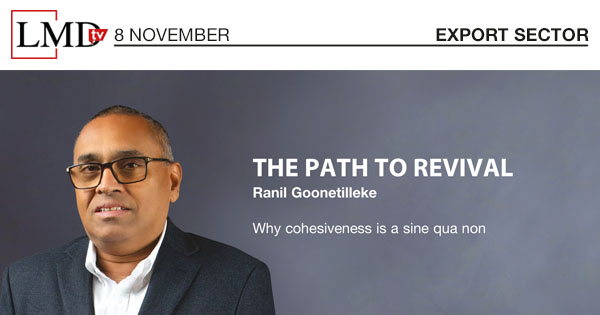 Sri Lanka’s export sector is facing mounting challenges in its quest to revive what is a crucial arm of the national economy. According to the Chairman of the Exporters Association of Sri Lanka Ranil Goonetilleke, out of the many factors that have adversely impacted exports, the global landscape has been the most telling.
Sri Lanka’s export sector is facing mounting challenges in its quest to revive what is a crucial arm of the national economy. According to the Chairman of the Exporters Association of Sri Lanka Ranil Goonetilleke, out of the many factors that have adversely impacted exports, the global landscape has been the most telling.
He explained that although COVID-19 affected local exports, the global phenomenon that resulted in economic slowdowns in most countries led to the challenges we face today.
“However, events that occurred thereafter were unique to Sri Lanka, which impacted all sectors including exports,” he said.
In this regard, he listed several factors – such as the fertiliser ban, economic turmoil, the forex crisis and power shortages – all of which resulted in a period “where economic activity virtually came to a standstill.”
Goonetilleke noted how things worsened “when stories of our internal turmoil were reported in the news, and played over and over again on global TV channels and social media.”
He explained: “Sri Lanka [was] losing its credibility. Our buyers naturally sought alternative supply channels from other countries. In addition, spiralling inflation led to cost increases. Exposed to a beating from both [these factors], margins reduced.”
And he added: “We also passed on our cost increases to the market; and we out-priced our products. Now the challenge is to regain our lost market share while at the same time rebuilding trust and restoring confidence in our ability to supply continuously.”
“A cohesive effort is needed involving all stakeholders; the exporters cannot fight [this] alone,” he stressed.
As for the downturn in apparel exports, he noted how – despite serving and saving the country for decades – the sector is facing severe issues today.
He observed: “Apparel and textiles have around a 45 percent share of [the] export basket – around US$ 6 billion. Unfortunately, global demand has dropped and led to about a 20 percent decline, which has affected not only us but most manufacturing countries.”
Goonetilleke affirmed that the apparel industry has had to lay off a large number of people, adding: “But the main issue is the global economic crisis – it has destroyed the demand for garments.”
He explained that the US is facing a downturn – and that it is the main importer of apparel from Sri Lanka; it accounts for about 76 percent of our apparel exports while the other markets are the UK and EU: “All these markets are facing economic downturns and high inflation so consumers are more careful in their discretionary spending.”
The Chairman of the Exporters Association of Sri Lanka asserted that the economic crisis did not necessarily cause the challenges faced by the apparel industry: “Even during the crisis, the industry managed because export income was coming in. But what’s happened globally has impacted the industry.”
Goonetilleke also emphasised the importance for Sri Lanka “to create a more exporter-friendly environment.”
He elaborated: “Exporters are inconvenienced with outdated procedures and manual systems where they [are] sometimes forced to spend loads of time and effort to manage the regulatory impediments… and time is money.”
“Also, if you’re exporting a product, all touch points in the process – including logistics and all those who are involved, the regulatory authorities included – must be quality minded and cohesive,” he urged, adding that “the customer should receive products on time and the highest quality possible.”
He explained this by citing tourism as an example: “We have to ensure that tourists have a good experience. If we’re serious about attracting foreign visitors, even things like road discipline have to be given careful thought.”
“Everyone in the social fabric has a role to play,” he said in conclusion, adding that “we all have to shoulder the responsibility of creating an export-friendly society.”



